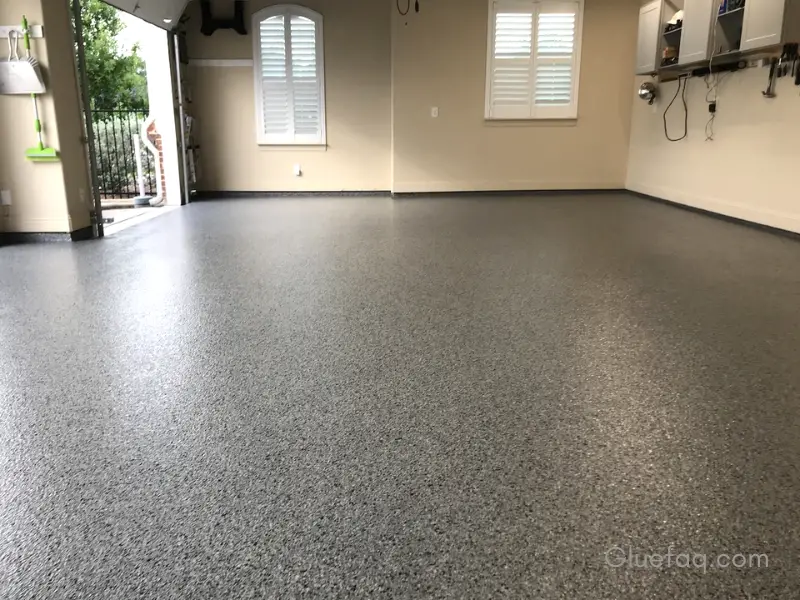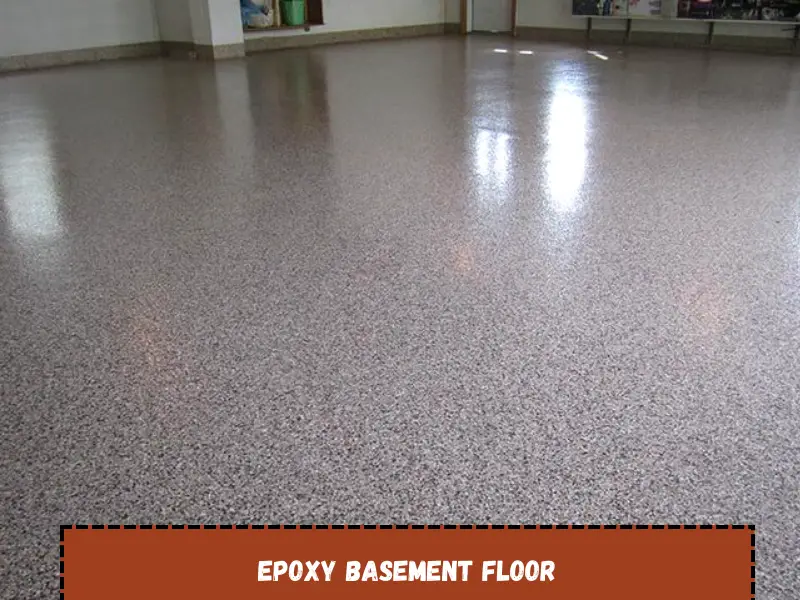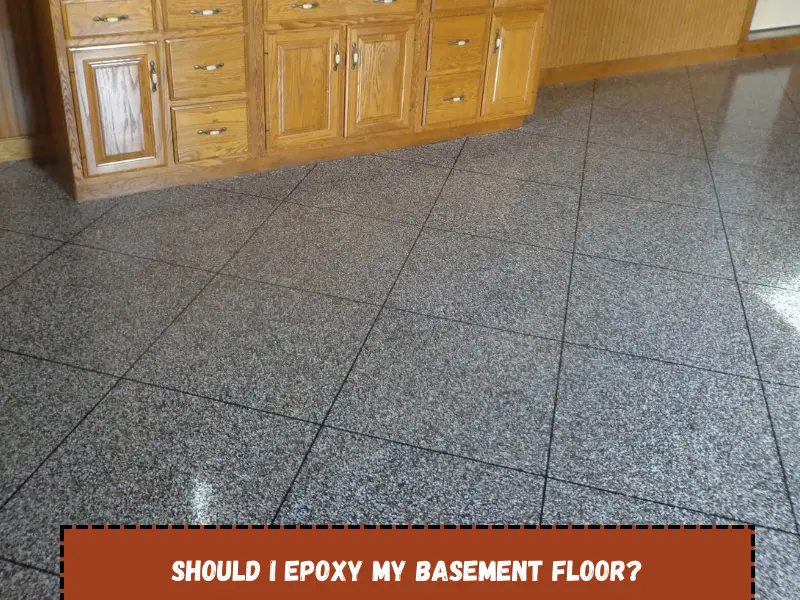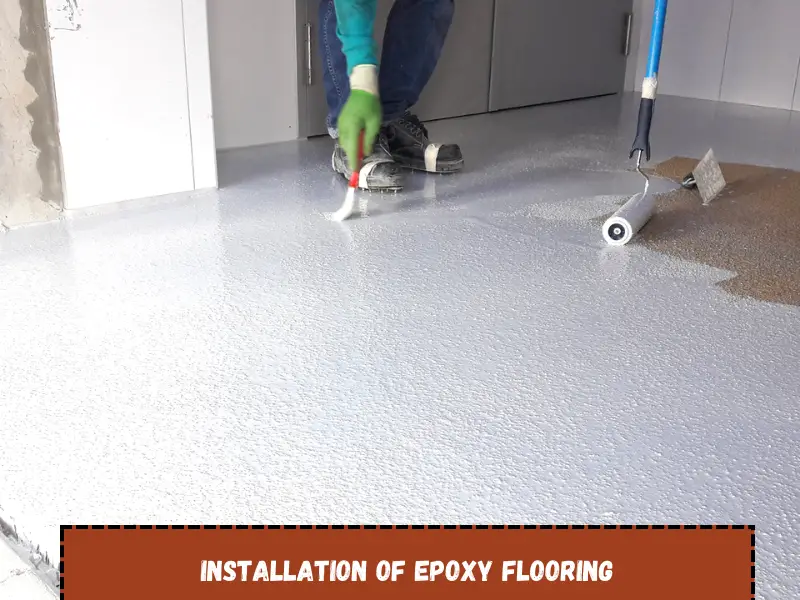Are you considering updating your basement floor with an epoxy finish? If so, you’ve come to the right place. In this ultimate guide, we’ll take a deep dive into all things related to epoxy basement floors.

From the various types of epoxy finishes to the best tools and techniques for applying the product, this guide has you covered. So read on to learn everything you need to know about epoxy basement floors!
Epoxy Basement Floor
Epoxy is a type of thermosetting polymer that is made by mixing two different components: a resin and a hardener. When these two components are combined, a chemical reaction occurs that causes the mixture to cure and harden into a strong, durable material.
Epoxy is commonly used as an adhesive, coating, or filler because of its excellent bonding strength, chemical resistance, and ability to withstand high temperatures and mechanical stress.
It is often used in construction, automotive, marine, and aerospace industries, as well as in art and crafts applications. Epoxy comes in various formulations, each with specific properties tailored for different applications.

Some types of basement epoxy floorsare designed to cure quickly, while others may take several hours or even days to fully cure.
The viscosity of the mixture can also vary depending on the application, with some being runny and others being thicker and more viscous.
6 Different Types of Epoxy Basement Flooring
Several different types of epoxy flooring can be used in the basement depending on your personal choice and considering the pros and cons of each type.
Each type has unique properties and applications. Some of the most common types of epoxy basement floors include:
Self-leveling epoxy:
This type of epoxy is designed to flow and self-level, making it ideal for use on uneven surfaces. It creates a smooth, seamless surface that is easy to clean and maintain.
Metallic epoxy:
This type of epoxy contains metallic pigments that create a unique, three-dimensional effect. It is often used in commercial and residential settings to create a high-end, modern look.
Quartz-filled epoxy:
This type of epoxy contains colored quartz aggregates that are mixed into the epoxy resin to create a textured, slip-resistant surface. It is often used in commercial and industrial settings where safety is a concern.
Terrazzo epoxy:
This type of epoxy contains marble or other decorative aggregates that are mixed into the epoxy resin to create a colorful, durable surface. It is often used in high-traffic commercial settings, such as airports and shopping malls.
Mortar epoxy:
This type of epoxy contains a sand or other aggregates that are mixed into the epoxy resin to create a thicker, more durable surface. It is often used in industrial settings where heavy machinery and equipment are present.
Anti-static epoxy:
This type of epoxy contains conductive materials that help to dissipate static electricity. It is often used in electronics manufacturing and other industries where static electricity can cause damage or safety hazards.
How Much Does it Cost to Epoxy a Basement Floor?
The cost of epoxy flooring for a basement can vary depending on several factors, including the size of the basement, the condition of the existing concrete, and the type of epoxy system chosen.
As a rough estimate, the cost of epoxy flooring for a basement can range from $3 to $12 per square foot.
But when professionally installed, it costs an average of $17.5 per square foot, that’s about $7000 for a 1000 per square foot basement.
Some factors that can affect the cost of epoxy flooring for a basement:
1- Square footage:
The larger the basement, the more epoxy material will be required, and the higher the cost will be.
2- Condition of the concrete:
If the concrete is in poor condition and requires extensive repair work before the epoxy can be applied, the cost may be higher.
3- Type of epoxy system:
There are several types of epoxy systems available, ranging from basic coatings to more advanced techniques with additional features such as decorative flakes or non-slip additives. The cost of the epoxy system will depend on the level of complexity and features.
4- Installation method:
If you hire a professional to install the epoxy flooring, the cost will be higher than if you do it yourself. However, professional installation may be necessary to ensure a high-quality result.
5- Location:
The cost of epoxy flooring can vary by location and may be higher in areas with a higher cost of living.
It is important to get a quote from a reputable contractor to determine the exact cost of epoxy flooring for your basement. This will help you to budget appropriately and ensure that you get a high-quality result.
Should I Epoxy my Basement Floor?
Epoxy flooring can be a good option for basements, as it can help to protect the concrete floor
from moisture, stains, and damage.

However, there are several pros & cons to consider before deciding if epoxy flooring is the right choice for your basement:
Pros of Epoxy Floors in Basement
● Epoxy basement floor coatings are the perfect choice for homeowners who want to make their basements look great while protecting them from damage.
● Floors are long-lasting, durable, and very easy to maintain, making them an ideal choice for any basement.
● Epoxy floors provide a waterproof layer of protection, as well as protection against dirt and other debris.
●They come in a variety of colors and patterns, allowing you to customize your basement to perfectly fit the aesthetic of your home.
● The several coatings of the Basement floor epoxy also provide several additional benefits that make them a desirable choice for many homeowners.
● They are highly resistant to chemicals, fire, and abrasions, making them a great choice for households with children or pets.
● Additionally, epoxy floors are non-porous, which means that spills and messes are easily wiped away.
● Finally, epoxy floors are deficient maintenance and can be cleaned quickly with a mop and warm water.
All of these features make epoxy basement floors a great choice for any homeowner looking to make their basement a safe and attractive space.
Cons of Epoxy Floors in Basements
● Epoxy flooring can be quite slippery, especially when wet. This can be a concern in basements that are used as living spaces, particularly if there are children or elderly individuals in the home.
● The concrete must be thoroughly cleaned and prepped before the epoxy can be applied, which can be time-consuming and may require specialized equipment.
● Applying epoxy flooring is a multi-step process that requires careful attention to detail.
● If the epoxy is not applied correctly, it may not adhere properly or may develop cracks or other issues over time.
● Epoxy flooring can be more expensive than other flooring options, such as carpet or vinyl.
● While epoxy flooring is very durable, it can be difficult to repair if it becomes damaged or develops cracks.
How to Install Epoxy Basement Flooring?
If you are wondering how to epoxy a basement floor, then have a look at the following steps which clearly explain the installation of epoxy flooring in a basement:

Prepare the surface: The first step is to prepare the concrete surface by cleaning it thoroughly and repairing any cracks or damage.
This typically involves using a grinder or shot blaster to remove any existing coatings, stains, or debris, and filling any cracks or holes with a concrete patching compound.
Apply a primer: Once the concrete surface is clean and dry, a primer is applied to help the epoxy adhere properly. The primer is typically applied with a roller or sprayer and allowed to dry according to the manufacturer’s instructions.
Mix the epoxy: The epoxy resin and hardener are mixed according to the manufacturer’s instructions. It is important to mix the epoxy thoroughly to ensure proper curing.
Apply the epoxy: The mixed epoxy is poured onto the surface and spread out using a roller or squeegee. It is important to work quickly, as the epoxy will begin to cure within a few hours. If desired, a non-slip additive or decorative flakes can be added to the epoxy while it is still wet.
Allow the epoxy to cure: The epoxy must be allowed to cure according to the manufacturer’s instructions. This typically involves allowing the epoxy to dry for 24-48 hours before walking on it, and 7-10 days before placing heavy objects on it.
Apply a topcoat: Once the epoxy has cured, a topcoat is applied to provide additional protection and durability. The topcoat is typically applied using a roller or sprayer and allowed to dry according to the manufacturer’s instructions.
It is important to follow the manufacturer’s instructions carefully when installing epoxy flooring in a basement, as improper installation can result in issues such as peeling, cracking, or discoloration.
It may be necessary to hire a professional installer to ensure that the epoxy is applied correctly and to minimize the risk of problems.
Gluing Hardwood Floors to Concrete
How to Maintain Epoxy Flooring?
Epoxy flooring is a durable and low-maintenance flooring option that can last for many years with proper care. Here are some tips for the maintenance of epoxy basement floors:
Regular cleaning: Sweep or vacuum the floor regularly to remove dirt and debris. You can also use a damp mop or a soft-bristled brush to clean the surface as needed.
Avoid harsh cleaners: Harsh chemicals and abrasive cleaners can damage the epoxy surface, so it is important to use gentle cleaners that are specifically designed for use on epoxy flooring. Avoid using vinegar, ammonia, or citrus-based cleaners, as these can also damage the surface.
Wipe up spills promptly: If you spill something on the floor, clean it up promptly to avoid staining or damaging the epoxy surface.
Avoid heavy objects: While epoxy flooring is durable, heavy objects can still cause damage if they are dragged across the surface. To avoid damage, lift heavy objects rather than dragging them across the floor.
Protect the surface: To protect the epoxy surface from scratches and wear, use felt pads on furniture legs and avoid wearing high heels or shoes with cleats on the surface.
Perform routine maintenance: Depending on the amount of traffic and wear and tear, it may be necessary to perform routine maintenance on the epoxy surface. This may involve applying a new topcoat or touching up any areas that have become worn or damaged over time.
By following these tips and performing routine maintenance as needed, you can keep your epoxy flooring looking great for many years to come.
Final Words
In summary, while epoxy flooring can be a great choice for basements, it is important to consider the potential cons before deciding if it is the right option for your home.
If slipperiness, preparation time, installation complexity, cost, or limited repair options are a concern, you may want to consider other flooring options.
